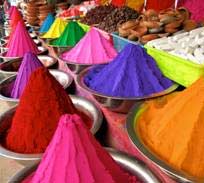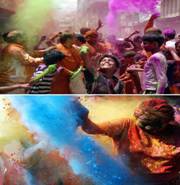On this day, people hug and wish each other 'Happy Holi'.Holi celebration begins with lighting up of bonfire on the Holi eve. Numerous legends & stories associated with Holi celebration makes the festival more exuberant and vivid. People rub 'gulal' and 'abeer' on each others' faces and cheer up saying, 'bura na maano Holi hai'. Holi also gives a wonderful chance to send blessings and love to dear ones wrapped in a special Holi gift. This year Holi was celebrated on 1st of March and in the year 2011 Holi is likely to fall on the 20th of March.
History
Holi is supposed to be a very ancient festival belonging to the period of Aryans many centuries before Christ. The festival being dominated among Aryans is also another reason why it is still being celebrated with great zeal in Northern and Eastern part of India. Originally Holi was popularly known as Holika and there was a detailed description about this festival in early historical works like Jaimini's Purvamimamsa-Sutras and Kathaka-Grhya-Sutras.There are also notes about the Holi festival in many religious books. Historical records says that in those days it was a special rites performed by a married women on a full moon day for the well being and the prosperity of their family. But however over years and periods the actual meaning of the festival has changed along with its legends.
Legends and Mythology
 Holi literally means 'burning'. Though there are so many legends associated with Holi the most believed one is the story associated with demon king Hiranyakashyap who wanted the entire kingdom to worship only him but unfortunately his son Prahlad became a great devotee of Lord Narayana.Hiranyakashyap was not able to take this, so he asked his sister Holika to set a blaze of fire with his own son for she had a power of not getting affected by the fire. But however she forgot the fact that it works only when she gets into the fire alone.Holika reaped for her sinister desires and Prahlad was saved by Lord Narayana.The festival, therefore, celebrates the victory of good over evil and also the triumph of devotion.
Holi literally means 'burning'. Though there are so many legends associated with Holi the most believed one is the story associated with demon king Hiranyakashyap who wanted the entire kingdom to worship only him but unfortunately his son Prahlad became a great devotee of Lord Narayana.Hiranyakashyap was not able to take this, so he asked his sister Holika to set a blaze of fire with his own son for she had a power of not getting affected by the fire. But however she forgot the fact that it works only when she gets into the fire alone.Holika reaped for her sinister desires and Prahlad was saved by Lord Narayana.The festival, therefore, celebrates the victory of good over evil and also the triumph of devotion.According to another legend the eastern part of India especially in Bengal and Orissa the birthday of Shri Chaitanya Mahaprabhu who lived during 1486 - 1533 A.D.was celebrated as Holi.Another legend states that it was Lord Krishna who started the tradition of playing with colours and applying it on Radha and other Gopis.Soon this tradition was picked up among the people and was celebrated as Holi.Though there are so many other legends associated with Holi like the legend of Shiva and Kaamadeva and those of Ogress Dhundhi and Pootana the foremost reason behind its celebration is triumph of good over evil.
Customs and tradition
There are several customs and traditions performed on and however it varies from one place to another. On the previous day of Holi the coloured powder which is commonly known as Gulal is got ready and the coloured water is placed in a brass pot known as lota.Traditionally though only natural colours got from flowers and herbal products were used, which is now in most of the places is replaced by artificial colours.As a part of the custom the coloured water is first sprinkled by the eldest member of the family on the rest. People lit up bonfires in the evenings where they sing and dance around it. This bonfire signifies the victory of Prahlad over his wicked aunt Holika.People take embers from this holy fire to kindle their own domestic fires.In some areas they also roast barley seeds to eat which also symbolizes the prediction of the harvest for the coming year depending on the degree to which the seeds are roasted. The actual festival of Holi of spraying colours starts on the next morning where children, men and women form separate groups and visit each other's houses smearing each other's faces and bodies with 'aabir' and 'gulal' and spurting colored water on people using 'pichkaris'and water balloons.Thus during Holi people befriend even their enemies and make a new beginning. As a part of its custom people prepare some traditional recipes like 'Gujias''Puran Poli'and 'Thandai'.Thandai is a cool drink which is a mixture of almonds, chilled milk and sugar.Thandai is sometimes mixed with an intoxicating substance called as 'bhang'. The custom of applying Tilak on the forehead of everyone who visiting the home is still followed during Holi.
Celebration of Holi in India
 Holi is nothing but the celebration of colours.Though it is been celebrated for ages the popularity of the festive is rising with every passing year. The main aspect of the celebration of holi is the triumph of good over evil but off late it is becoming more of a carnival of colors, a community festival and a tradition of welcoming the spring. It is mainly celebrated on Phalgun Purnima which comes in February end or early March.
Holi is nothing but the celebration of colours.Though it is been celebrated for ages the popularity of the festive is rising with every passing year. The main aspect of the celebration of holi is the triumph of good over evil but off late it is becoming more of a carnival of colors, a community festival and a tradition of welcoming the spring. It is mainly celebrated on Phalgun Purnima which comes in February end or early March.The exuberant festival of colour starts with the bonfires in the evenings where they sing folksongs and dance around it with beating of dholak.The actual festival of Holi of spraying colours starts on the next morning where children, men and women form separate groups and visit each other's houses smearing each other's faces and bodies with 'aabir' and 'gulal' and spurting colored water on people using 'pichkaris'and water balloons. No festival is complete without special delicaies.The mouth
watering holi specialities includes gujiya, malpuas, mathri, puran poli, dahi badas and with glasses full of thandai which is usually mixed with a intoxicating drink called Bhang. People also visit homes, distribute sweets and greet each other. In some places they also celebrate by breaking a pot full of buttermilk which is hung high where a group of boys form a human pyramid and one of them break the pot and womenfolk throw buckets of colour water on them and sing folk songs. The entire nation takes part irrespective of race, culture and ethnic background. There is a holi bash celebration arranged in Mathura and Barsana.
Celebration of Holi Worldwide
By origin though Holi is an Indian festival, it has gained an international populace today and is been celebrate in different parts of the country. Since Indian are settled in different parts of the country the celebration of the festival of colour is also spread widely. Celebration of Indian festivals is much more than in India for it gets them reminded of their motherland and their loved ones. It also gives them a chance among the Indians living there to strengthen their ties and bonds. The celebration there also includes the traditional way of smearing colour on each other's face and splashing water by using pichkaris and balloons.They greet each other and exchange sweets. In USA the Holi festival is organized by religious organizations and societies where they conduct musical programs and meets.Holi is also highlighted by parades where they rejoice to the extent playing with colours.The British city of Leicester is particularly known for its love for celebrating Indian festivals. Celebration here is again similar to that of their home where social gatherings are arranged and people greet each other with exchange of sweets.Holi is celebrated in South Africa with equal josh as in any other part of the country.
No festival is complete without sweets and food and so is Holi.There are number of famous and delicious dishes prepared during Holi which are cherished by family members and friends with great fervor. Some of the most common dishes prepared during Holi are Gujia is a sweet dish quite common in North India.
- Puran Poli are first made as small doughs and then fried and served hot.
- Papri is a snack containing meethi leaves and savored by chutnii.
- Dahi Bhalle is again another snack which is eaten with chutnii and curd.
- Malpua is a sweet dish made of flour served with rabri which can be stored for weeks to eat.
- Saffron Syrup is a cold drink served during Holi.
- Bhang is prepared by squashing the buds and leaves of cannabis and made into a green paste and then added to a mixture of milk, ghee and spices.
- Thandai is a cool drink which is a quite famous recipe for Holi and Shivarathri.It is made of poppy seeds, aniseeds, black peppercorns and rose petals, the buds and leaves of Cannabis using a mortar and pestle into a green paste. It is then mixed with milk, ghee, and spices which is latter on served along with ice cubes in the glass.

